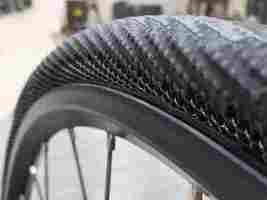Everything you need to know about the high tech tires of tomorrow
While most of our attention focuses on the body and engine of the car, the functionality and efficacy of tires are equally important.

Technology, materials science, and engineering are creating longer-lasting, more resilient, more sustainable tires.
Let’s take a look at some of the latest trends:
Airless


The SMART Tire Company is working to create “super elastic” airless tires in partnership with NASA.
SMART stands for Shape Memory Alloy Radial Technology. And the tires are something special. They’re made of NiTinol+ (nickel-titanium), a shape memory alloy that’s elastic like rubber, yet strong like titanium.
NASA originally patented the idea in response to the challenge of developing tires for Mars, where there are no roads, temperatures can reach -100C, and tire performance is mission-critical.
While the NiTinol shape memory alloys are extremely resilient, the company is also focusing on material recycling and mechanical repair, by reshaping and heat-treating localized damage or replacing individual elements.
NASA Glenn Laboratory has been developing the technology for 7+ years, and the organization is at an advanced prototype phase. Their first product will be a bicycle tire launching in Q4 of 2022.
Sensors
Tire pressure monitoring systems (TPMS) are mandated by law since 2008 in the US and 2012 in Europe. Sensors placed on the tire’s rim send data to the vehicle’s dashboard, monitoring the amount of tire inflation.
But sensors are being used in a range of predictive maintenance scenarios to prevent accidents caused by worn tires .
Tyrata is a tire sensor and data management company that uses sensors to monitor, track, and predict tire tread life.
An example is the DOS, Drive-Over System, a speed bump-like unit that measures tire tread wear when a vehicle drives over it . The sensor data goes to a cloud-based data analytics platform to deliver real-time analytics about the tires’ health.
The system fully automates tread-depth measurements and analytics needed for efficient tire management and safe vehicle operation.
Dandelions and soybean oil
Last year Continental announced that it’s working on a tire made from renewable, recycled, and traceable materials.
Enter the Conti GreenConcept . Each tire consists of 35% renewable bio-materials. These include natural rubber from dandelions, silicate from rice husks ash, and vegetable oils and resins. This reduces the need for crude oil, traditionally found in tires.
It’s also composed of 17% recycled materials, namely reclaimed steel, recovered carbon black, and polyester yarn.
They’re not the only company switching to greener materials.
Goodyear has replaced petroleum-based components with soybean oil in some tread compounds.
Bridgestone has its sights set on guayule, an evergreen shrub with a similar material makeup to the conventionally used para rubber trees.
Tires for EVs
Electric vehicles have specific challenges when it comes to tire health . The cars weigh more and bear the brunt of instant torque and acceleration. Combined, these lead to an increase in wear and tear. Worn tires increase a tire’s rolling resistance and reduce efficiency.
Last year, Michelin and Goodyear released their first tires designed exclusively for electric vehicles. Tire maker Pirelli recently added its own EV-specific tire to the mix.
Last week tire company Hankook Tire announced plans to launch iON, its first family of tires specially designed for EVs. The new iON tire development characteristics include further reduced rolling resistance, notably lower rolling-noise characteristics and high resilience. This means more range per battery charge and an overall more enjoyable driving experience.
Tire makers are investing heavily in R&D, and we can expect to see continually improving commitments to materials innovation, data-driven insights, and circular design .
American EV sales skyrocket 81% year-on-year
The US seems to be coming round to electric vehicles in a big way.

The sales of EVs experienced record growth the first quarter of 2021, up 81% over the same period last year.
According to an analysis of the US auto market by Cox Automotive and Kelley Blue Book , the combined sales of electric vehicles (EVs, HEVs/PHEVs) surpassed 300,000, that’s an increase of 132,000 over the same period in 2020.
Battery EV sales witnessed an increase of 44.8%, reaching almost 100,000.
Hybrid vehicle sales outperformed both EVs and the overall market, and doubled to more than 200,000, with an 105% increase.
Electric vehicle sales now represent 7.8% of the total US auto market. This is a 3% increase compared to the same period last year.
Tesla remains the number one seller of EVs with 69,300 vehicles and a 71% market share – although, it dropped from 83% in the first quarter of 2020.
The best-selling EVs across the quarter are the Tesla Model Y, followed by former number one, the Tesla Model 3. The Chevrolet Bolt and Ford Mustang Mach-E take third and fourth place, respectively.
Hybrid sales are dominated by Toyota, largely supported by its RAV4, which is its best-selling hybrid vehicle in the US (32,263 units).
Honda comes in second place, selling more that 22,000 units. Ford is the third most popular hybrid seller, registering more than 18,000 electrified vehicles.
Do EVs excite your electrons? Do ebikes get your wheels spinning? Do self-driving cars get you all charged up?
Then you need the weekly SHIFT newsletter in your life. Click here to sign up .
EV owners looking at extra costs as UK moves to plug road tax gap
The UK‘s shift to EVs will come with a heavy price, an expected £40 billion ($56bn) loss in the Treasury’s funds.

On Wednesday, Greener Transport Solutions, a non-profit group that provides recommendations to central and local government, submitted to MPs a report , aimed at tackling this problem.
Specifically, the report proposed a mandatory per-mile road pricing scheme by 2030, to coincide with the sales ban on internal combustion vehicles.
The organization considers this measure a “fiscal imperative.”
With the electric vehicles being exempt from vehicle excise duty (an emissions based tax) and the expected decrease in fuel demand, the Treasury will loose 28 billion ($39bn) from fuel duty, £6 billion ($8bn) from VAT on fuel, and £6.5 billion ($9bn) from VED charges.
The rates of the road pricing scheme will be based on distance, vehicle weight, emission, and traffics levels. The distance charge, for instance, is set at 2p (0.03c) per km for cars, 3p (0.04c) per km for vans, and 6p (0.08c) per km for lorries.
The proposed scheme needs to go hand in hand with the provision of incentives to prospect EV buyers, the report claims.
Therefore, it recommends a 33% discount for models up to £35,000 for buyers that voluntary opt for the road charges from 2023, and a £3,000 grant for those who scrap their old vehicle (if more than 10 years old) and switch to an EV instead.
Do EVs excite your electrons? Do ebikes get your wheels spinning? Do self-driving cars get you all charged up?
Then you need the weekly SHIFT newsletter in your life. Click here to sign up .